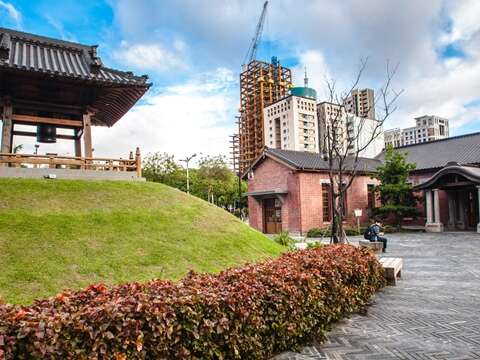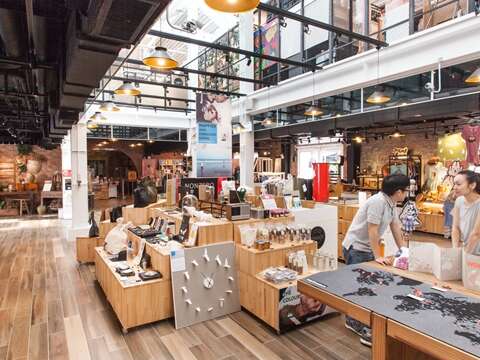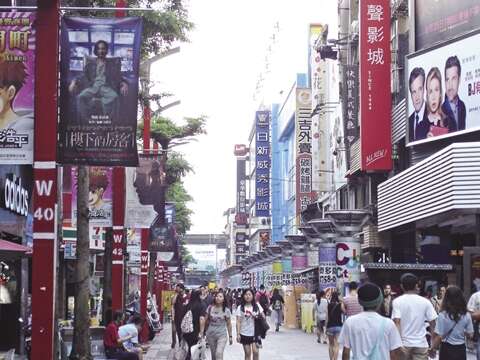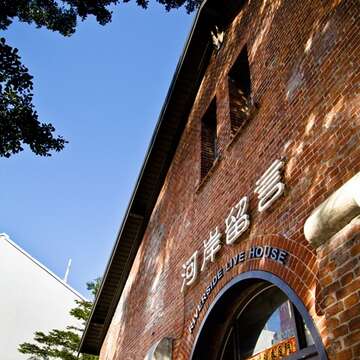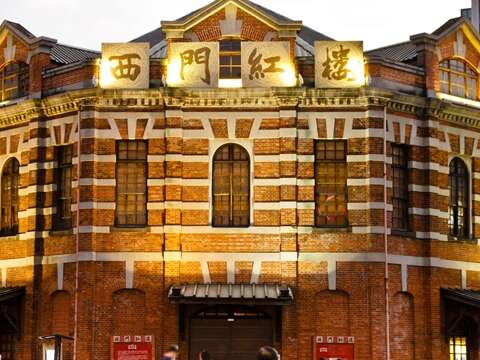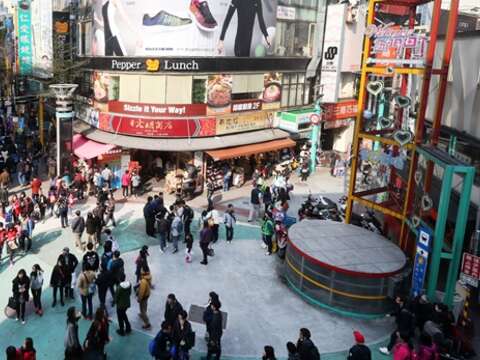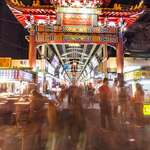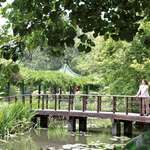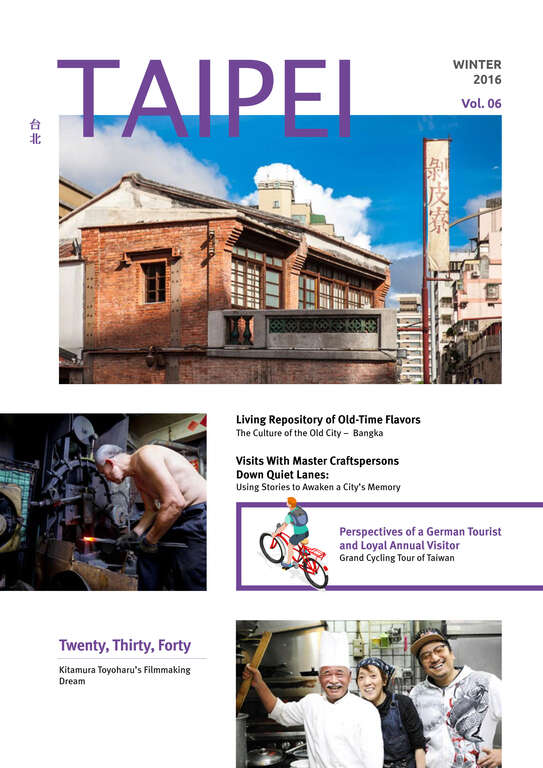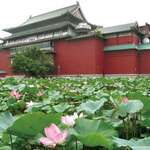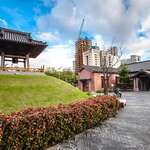Post date:2017-03-10
2132
The Rise of Post-Youth Culture and Creativity
Arts Pilgrimage – Ximending
Article_Xu Ciqian
Photos_Taipei City Government Department of Information and Tourism, Shi Chuntai
Tattoos, pop music, trendy fashions, imported goods, movies – today’s Ximending is a veritable temple of youth subcultures. However, in the late Qing Dynasty, this area, directly outside the Ximen (西門) or West Gate of the old walled city, was a cultural wasteland. It wasn’t until Taiwan became a Japanese colony that the Japanese, in a show of strength and dominance, created a high-end entertainment and commercial district here, and mapped out residential quarters for Japanese nationals. Fifty years of Japanese rule left the Taiwan people deeply influenced by Japanese popular culture, and it was here that the first dedicated movie theater in Taiwan appeared. Ximending became a key center for the growth of Taiwan’s film-entertainment culture. After the end of the Second World War, Taipei absorbed a flood of refugees from the mainland China, and business-savvy immigrants from Shanghai, in particular, took to opening department stores and other businesses in Ximending, turning it into a pleasure zone for singing, dancing and shopping. In the 1960s, the China Plaza was built along the Ximending and old walled city area boundary line, linking the two and in a single leap creating the nation’s commercial and entertainment heartland.
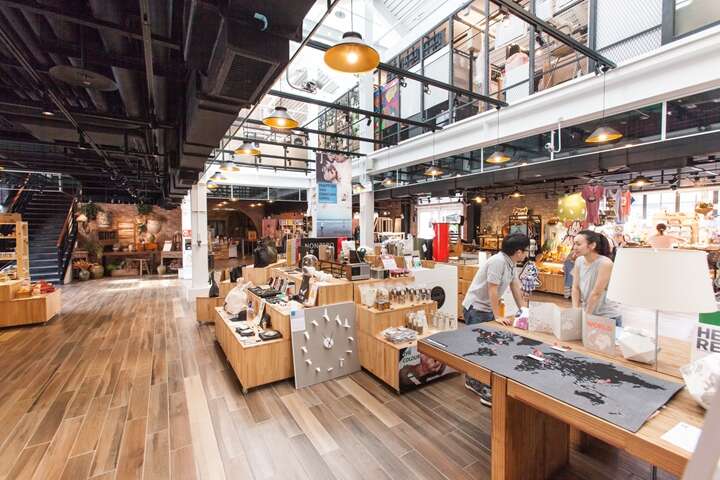
▲In recent years, Ximending has been relaunched as a cultural and creative platform; the Taipei Culture Foundation has employed a diversified management approach to make The Red House a landmark attraction. (Photo: Shi Chuntai)
In the world created in the pages of the novel Ryu, Ximending’s long period of prosperity has peaked, but the enclave remains the gathering spot of choice for young people. In those days, the area attracted gang members, young runaways, and youngsters playing hooky, engaging in the familiar outlets of bored youth, playing pool and getting in gang fights. For that generation of young people with nowhere to vent their energies, an outlet was found in Ximending, and a unique imprint on life was forged.
Though only a limited amount of ink is spent on Ximending in Ryu, the relation between the prosperity and decline of the area and the oft-mentioned China Plaza is clear. Major transportation construction was launched in the 1990s after the China Plaza was demolished, and the city’s west district fell into what was called a “traffic dark age.” Ximending went into a decline that lasted until a little more than a decade ago, when the government began injecting resources, transforming the area into a pedestrian-friendly commercial district. This, matched with the regeneration of its historic buildings, has rekindled Ximending’s historical and cultural value. Ximending’s prosperity and glory has reappeared before the eyes of the public.
The Red House – Revivified Splendor of an Arts and Culture Bastion
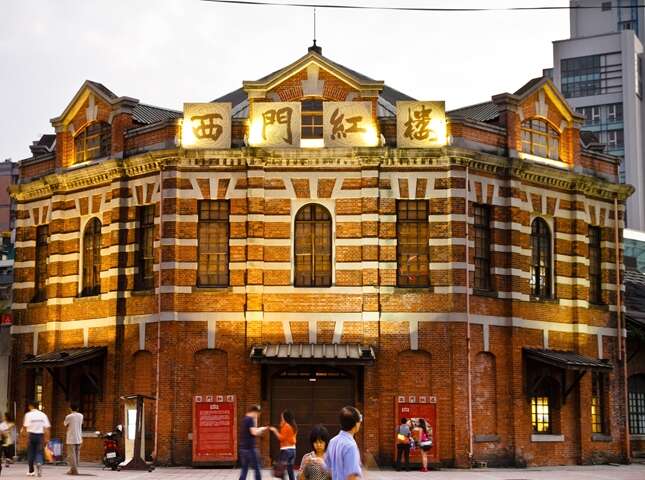
▲ The Red House, built as Taiwan’s first public market, is Taiwan’s best-preserved Class III National Monument. (Photo: Lu Enci)
Exit MRT Ximen Station and, whether you walk toward the pedestrian area or along Chengdu Road (成都路), your eyes will almost surely be drawn to the red-brick building called The Red House (西門紅樓). Elegant during the day, bright and resplendent at night, since its construction over a hundred years ago The Red House has been a Taipei City entertainment diamond. Film screenings and theatrical shows both opened the eyes of young students and soothed the spirits of immigrants from mainland China.
However, the original role of what is today called The Red House was as Taiwan’s first public market. This is Taiwan’s best-preserved and most extensive Class III National Monument. The octagonal red-brick main building and market entrance in the shape of the Bagua (eight trigrams) were avant-garde for their time.
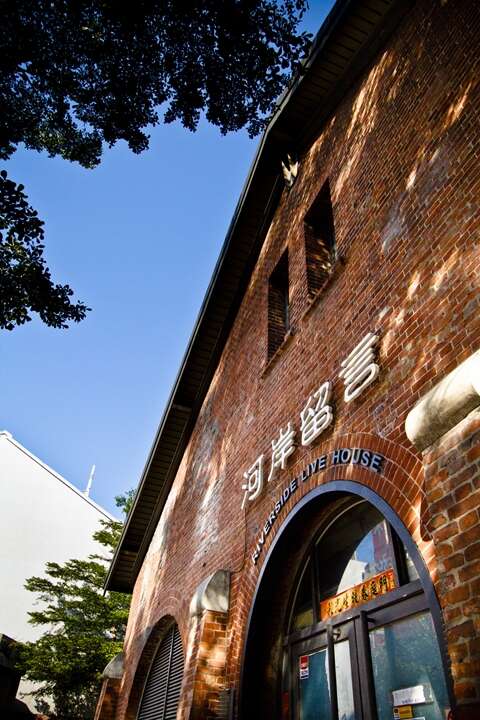
▲ The Riverside Live House and other venues are showcases of the energy of Ximending’s music scene. (Photo: Lu Enci)
In 2011, a comprehensive relaunch of Ximen Market restored The Red House to its original elegance. The Red House Theater (紅樓劇場) was reopened the following year, with various performance groups working together to reclaim the joy and excitement of the venerable marketplace. The public and private sectors thereafter continued to focus their attention on The Red House, organizing a variety of lively arts and culture activities and exhibitions of cultural and creative goods. Attractions include the theater on the second floor of the Octagon Building (八角樓), Creative Boutique (16工房) area in the Cruciform Building (十字樓), Riverside Live House (河岸留言), North Square Market for Artists & Designers (北廣場創意市集), South Square Outdoor Café area (南廣場露天咖啡區), and Moonlight Movie Theater (月光電影院). These have made The Red House a key cultural and creative development platform in the city’s west district.
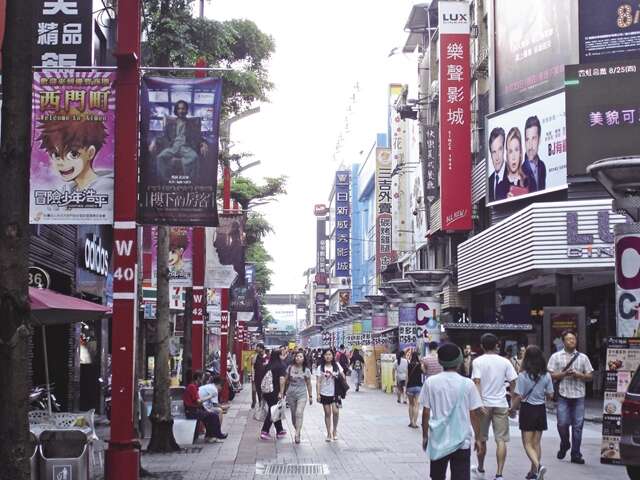
▲ Ximending was a key birthplace for movie entertainment in Taiwan; today cinemas are clustered along what is called “Cinema Street.”(Photo: Taipei City Government Department of Information and Tourism )
The Creative Boutique has been repositioned as a “life cultural and creative department store.” In addition to remodeling this unique space, integrating old and new, it has been made into a bazaar of Taiwan cultural and creative brands, sparking a rich surge of creative energy and stimulating international exchanges and cooperation. The weekend Market for Artists & Designers is a lively bazaar of colorful artist and designer stalls. With a new creative theme each month, the North Square bursts with a happy holiday atmosphere, attracting sightseers hunting for lifestyle-enhancing creative gems. The Outdoor Café area is a mini-forest of choices, a favorite spot with young folk for evening get-togethers filled with pleasant conversation. The cafes and bars here are LGBT-friendly, helping to make this an all-inclusive gathering spot for good food and drink known throughout Asia.
Different Eras of Ximending Fashion
From the fashionable public market of a 100-plus years ago to today’s bustling Ximen Pedestrian Area (西門徒步區), Ximending has been home to the trendiest shops.
In the 1980s and 1990s, cabarets, referred to as red envelope clubs, became very popular, with an especially flourishing cluster in Ximending. When this fad went into decline the folk-music restaurant, beloved by the young crowd, stepped in.Today, it is live stage shows that are all the rage with local youth, with Ximending in the vanguard, Riverside Live House and Legacy mini are the powerhouse drivers of Ximending’s dynamic music scene. As part of the Taipei Culture Foundation’s (台北市文化基金會) diversified management approach, a café, historical-materials exhibit, cultural and creative market, and cultural and creative development center have also been established, further solidifying the attraction of The Red House as a cultural and creative landmark.
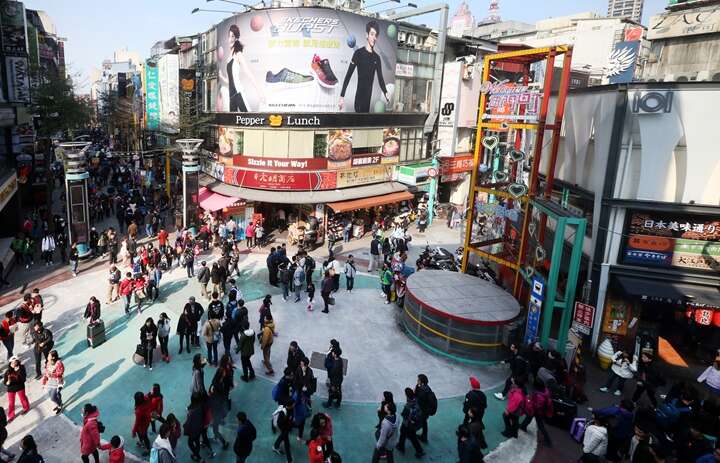
▲ Today’s Ximending is a veritable temple of youth subcultures. (Photo: Lai Jianhong)
The Red House is a cultural and creative bellwether, with scores and scores of inventive enterprises in the immediate area, among them trendy hair salons, spicy-hotpot joints, handmade beverage outlets, KTVs, and even backpacker hotels and hostels. Each has been a product of the times, hitting wave after wave, driving Ximending as a pop-culture mecca and stimulating consumption surges. A key difference between the Ximending of today and the yesterday of Ryu is that today’s youth believes in letting a “hundred flowers bloom,” meaning that everyone can do their own thing with no need of holding the passion inside. As long as there is kindred spirit, each makes his/her own unique contribution.It can be tattoos, it can be street dance, it can be good coffee, and it can even be the cultural-guide work once dominated by those more senior. The cultural landscape is thus like a kaleidoscope, changing endlessly.
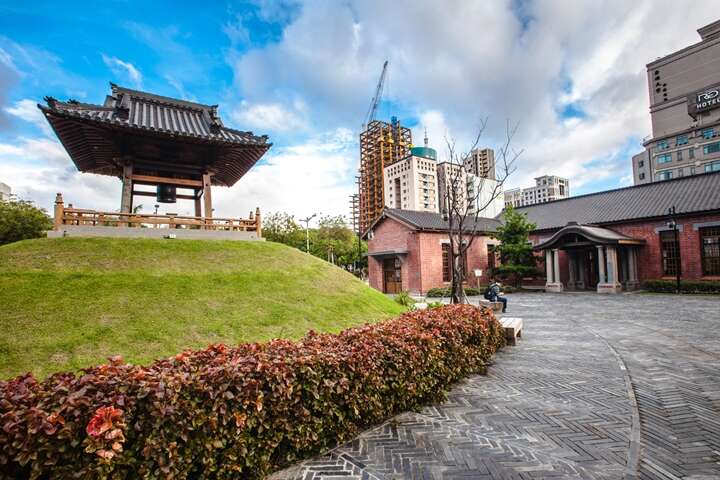
▲ Xibenyuan Temple, which exudes deep Japanese character, has been transformed into an arts, culture and leisure space. (Photo: Shi Chuntai)
From youth subculture to arts energy, there is a great injection of creativity and arts and culture activity. Ximending, as it always has for people who have spent part of their youth here, continues to bring endless surprises. On the one side colorful pop fashion reigns, yet on the other is rich historical depth. Beyond The Red House, just a short walk away is Xibenyuan Temple (西本願寺), another heritage site where original glory has been restored for the world to enjoy, sitting beautifully in characteristically quiet Japanese elegance. After being immersed in the incoming tide of Japanese and Korean pop fashion in Ximending’s bustling main area, change the pace with quiet moments in its oases of tranquility, savoring tea Japanese-style in Xibenyuan Temple Square or a coffee hipster-style in a creative café. Lively, colorful, and endlessly wonder-filled, in Ximending the things that change and the things that happily remain the same reflect the essential Ximen/West Gate area character, the perpetual air of vitality and creativity thrilling all who come.
Arts Pilgrimage – Ximending
Article_Xu Ciqian
Photos_Taipei City Government Department of Information and Tourism, Shi Chuntai
Tattoos, pop music, trendy fashions, imported goods, movies – today’s Ximending is a veritable temple of youth subcultures. However, in the late Qing Dynasty, this area, directly outside the Ximen (西門) or West Gate of the old walled city, was a cultural wasteland. It wasn’t until Taiwan became a Japanese colony that the Japanese, in a show of strength and dominance, created a high-end entertainment and commercial district here, and mapped out residential quarters for Japanese nationals. Fifty years of Japanese rule left the Taiwan people deeply influenced by Japanese popular culture, and it was here that the first dedicated movie theater in Taiwan appeared. Ximending became a key center for the growth of Taiwan’s film-entertainment culture. After the end of the Second World War, Taipei absorbed a flood of refugees from the mainland China, and business-savvy immigrants from Shanghai, in particular, took to opening department stores and other businesses in Ximending, turning it into a pleasure zone for singing, dancing and shopping. In the 1960s, the China Plaza was built along the Ximending and old walled city area boundary line, linking the two and in a single leap creating the nation’s commercial and entertainment heartland.

▲In recent years, Ximending has been relaunched as a cultural and creative platform; the Taipei Culture Foundation has employed a diversified management approach to make The Red House a landmark attraction. (Photo: Shi Chuntai)
In the world created in the pages of the novel Ryu, Ximending’s long period of prosperity has peaked, but the enclave remains the gathering spot of choice for young people. In those days, the area attracted gang members, young runaways, and youngsters playing hooky, engaging in the familiar outlets of bored youth, playing pool and getting in gang fights. For that generation of young people with nowhere to vent their energies, an outlet was found in Ximending, and a unique imprint on life was forged.
Though only a limited amount of ink is spent on Ximending in Ryu, the relation between the prosperity and decline of the area and the oft-mentioned China Plaza is clear. Major transportation construction was launched in the 1990s after the China Plaza was demolished, and the city’s west district fell into what was called a “traffic dark age.” Ximending went into a decline that lasted until a little more than a decade ago, when the government began injecting resources, transforming the area into a pedestrian-friendly commercial district. This, matched with the regeneration of its historic buildings, has rekindled Ximending’s historical and cultural value. Ximending’s prosperity and glory has reappeared before the eyes of the public.
The Red House – Revivified Splendor of an Arts and Culture Bastion

▲ The Red House, built as Taiwan’s first public market, is Taiwan’s best-preserved Class III National Monument. (Photo: Lu Enci)
Exit MRT Ximen Station and, whether you walk toward the pedestrian area or along Chengdu Road (成都路), your eyes will almost surely be drawn to the red-brick building called The Red House (西門紅樓). Elegant during the day, bright and resplendent at night, since its construction over a hundred years ago The Red House has been a Taipei City entertainment diamond. Film screenings and theatrical shows both opened the eyes of young students and soothed the spirits of immigrants from mainland China.
However, the original role of what is today called The Red House was as Taiwan’s first public market. This is Taiwan’s best-preserved and most extensive Class III National Monument. The octagonal red-brick main building and market entrance in the shape of the Bagua (eight trigrams) were avant-garde for their time.

▲ The Riverside Live House and other venues are showcases of the energy of Ximending’s music scene. (Photo: Lu Enci)
In 2011, a comprehensive relaunch of Ximen Market restored The Red House to its original elegance. The Red House Theater (紅樓劇場) was reopened the following year, with various performance groups working together to reclaim the joy and excitement of the venerable marketplace. The public and private sectors thereafter continued to focus their attention on The Red House, organizing a variety of lively arts and culture activities and exhibitions of cultural and creative goods. Attractions include the theater on the second floor of the Octagon Building (八角樓), Creative Boutique (16工房) area in the Cruciform Building (十字樓), Riverside Live House (河岸留言), North Square Market for Artists & Designers (北廣場創意市集), South Square Outdoor Café area (南廣場露天咖啡區), and Moonlight Movie Theater (月光電影院). These have made The Red House a key cultural and creative development platform in the city’s west district.

▲ Ximending was a key birthplace for movie entertainment in Taiwan; today cinemas are clustered along what is called “Cinema Street.”(Photo: Taipei City Government Department of Information and Tourism )
The Creative Boutique has been repositioned as a “life cultural and creative department store.” In addition to remodeling this unique space, integrating old and new, it has been made into a bazaar of Taiwan cultural and creative brands, sparking a rich surge of creative energy and stimulating international exchanges and cooperation. The weekend Market for Artists & Designers is a lively bazaar of colorful artist and designer stalls. With a new creative theme each month, the North Square bursts with a happy holiday atmosphere, attracting sightseers hunting for lifestyle-enhancing creative gems. The Outdoor Café area is a mini-forest of choices, a favorite spot with young folk for evening get-togethers filled with pleasant conversation. The cafes and bars here are LGBT-friendly, helping to make this an all-inclusive gathering spot for good food and drink known throughout Asia.
Different Eras of Ximending Fashion
From the fashionable public market of a 100-plus years ago to today’s bustling Ximen Pedestrian Area (西門徒步區), Ximending has been home to the trendiest shops.
In the 1980s and 1990s, cabarets, referred to as red envelope clubs, became very popular, with an especially flourishing cluster in Ximending. When this fad went into decline the folk-music restaurant, beloved by the young crowd, stepped in.Today, it is live stage shows that are all the rage with local youth, with Ximending in the vanguard, Riverside Live House and Legacy mini are the powerhouse drivers of Ximending’s dynamic music scene. As part of the Taipei Culture Foundation’s (台北市文化基金會) diversified management approach, a café, historical-materials exhibit, cultural and creative market, and cultural and creative development center have also been established, further solidifying the attraction of The Red House as a cultural and creative landmark.

▲ Today’s Ximending is a veritable temple of youth subcultures. (Photo: Lai Jianhong)
The Red House is a cultural and creative bellwether, with scores and scores of inventive enterprises in the immediate area, among them trendy hair salons, spicy-hotpot joints, handmade beverage outlets, KTVs, and even backpacker hotels and hostels. Each has been a product of the times, hitting wave after wave, driving Ximending as a pop-culture mecca and stimulating consumption surges. A key difference between the Ximending of today and the yesterday of Ryu is that today’s youth believes in letting a “hundred flowers bloom,” meaning that everyone can do their own thing with no need of holding the passion inside. As long as there is kindred spirit, each makes his/her own unique contribution.It can be tattoos, it can be street dance, it can be good coffee, and it can even be the cultural-guide work once dominated by those more senior. The cultural landscape is thus like a kaleidoscope, changing endlessly.

▲ Xibenyuan Temple, which exudes deep Japanese character, has been transformed into an arts, culture and leisure space. (Photo: Shi Chuntai)
From youth subculture to arts energy, there is a great injection of creativity and arts and culture activity. Ximending, as it always has for people who have spent part of their youth here, continues to bring endless surprises. On the one side colorful pop fashion reigns, yet on the other is rich historical depth. Beyond The Red House, just a short walk away is Xibenyuan Temple (西本願寺), another heritage site where original glory has been restored for the world to enjoy, sitting beautifully in characteristically quiet Japanese elegance. After being immersed in the incoming tide of Japanese and Korean pop fashion in Ximending’s bustling main area, change the pace with quiet moments in its oases of tranquility, savoring tea Japanese-style in Xibenyuan Temple Square or a coffee hipster-style in a creative café. Lively, colorful, and endlessly wonder-filled, in Ximending the things that change and the things that happily remain the same reflect the essential Ximen/West Gate area character, the perpetual air of vitality and creativity thrilling all who come.
Gallery
:::
Popular articles
 TAIPEI QUARTERLY 2016 WINTER Vol.06
TAIPEI QUARTERLY 2016 WINTER Vol.06 Women’s Volleyball Super-Spiker Wang Sin-Ting (TAIPEI QUARTERLY 2016 WINTER Vol.06)
Women’s Volleyball Super-Spiker Wang Sin-Ting (TAIPEI QUARTERLY 2016 WINTER Vol.06) Paiwan Skating ‘God of War’ Sung Ching-Yang (TAIPEI QUARTERLY 2016 WINTER Vol.06)
Paiwan Skating ‘God of War’ Sung Ching-Yang (TAIPEI QUARTERLY 2016 WINTER Vol.06) A literary World Flow Tour of Taipei-A Look at the Old City’s Elegance (TAIPEI QUARTERLY 2016 WINTER Vol.06)
A literary World Flow Tour of Taipei-A Look at the Old City’s Elegance (TAIPEI QUARTERLY 2016 WINTER Vol.06) The Culture of the Old City – Bangka (TAIPEI QUARTERLY 2016 WINTER Vol.06)
The Culture of the Old City – Bangka (TAIPEI QUARTERLY 2016 WINTER Vol.06) The Rise of Post-Youth Culture and Creativity Arts Pilgrimage – Ximending (TAIPEI QUARTERLY 2016 WINTER Vol.06)
The Rise of Post-Youth Culture and Creativity Arts Pilgrimage – Ximending (TAIPEI QUARTERLY 2016 WINTER Vol.06)
 The Rise of Post-Youth Culture and Creativity Arts Pilgrimage – Ximending (TAIPEI QUARTERLY 2016 WINTER Vol.06)
The Rise of Post-Youth Culture and Creativity Arts Pilgrimage – Ximending (TAIPEI QUARTERLY 2016 WINTER Vol.06)